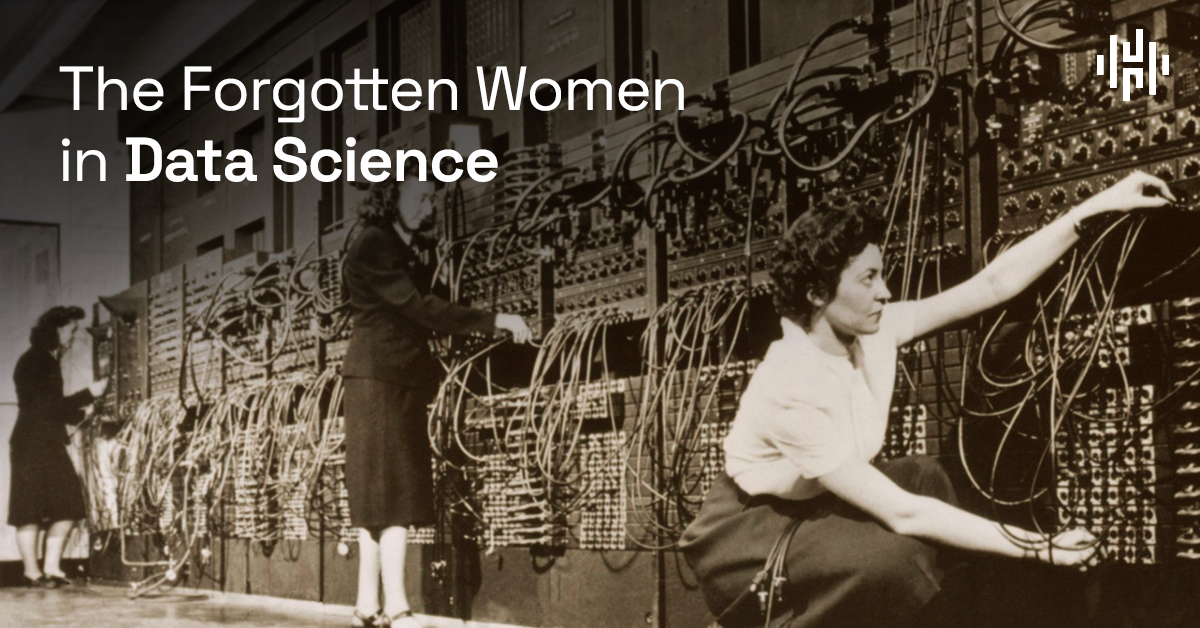On International Women’s Month, and more specifically on March 8th, it’s not uncommon to stumble upon listicles mentioning the life and achievements of brilliant women. It’s a great opportunity to take a moment, step back and take a look at the history of technology and how women played a pivotal role in creating some of the techniques and technologies we use today, on a daily basis.
However, I’ve always noticed how much of the content gravitates towards the achievements of specific individuals. If we’re trying to look at women’s contributions to the fields of artificial intelligence and technology, remembering specific cases remains a partial effort. I say this because history, as a social science, always attempts to recreate a picture of the past through the stories of those whose names we know and those whose names we’ll never find out.
In this blog, I’ll briefly explore the latter: the history of those groups of women who set the foundations for an industry, and whose early work in computing laid the groundwork for data engineering, computing and artificial intelligence.
Wartime and the Dawn of Women in Data Science
The 2014 film “The Imitation Game” tells the story of how Alan Turing and a team of talented cryptographers, among them mathematician Joan Clark, deciphered German messages that helped the Allies win the Second World War. Their work in the creation of the Bombe machine, used to discover the daily settings of the Enigma coding device used by the Germans, remains one of the best known advancements in cryptography and computing.
Yet the Bombe machine wasn’t the most used device in decoding the thousands of messages received daily at Bletchley Park, the home for code-breakers during the war. Because of the volume, most of the messages were processed in the Colossus, a machine that used vacuum tubes to perform Boolean and counting operations. Regarded as the world’s first programmable computer, the Colossus was primarily operated by women.
According to Marie Hicks in “Programmed Inequality: How Britain Discarded Women Technologists and Lost Its Edge in Computing,” British intelligence hired operators from the Women’s Royal Naval Services (also known as WRNS or “wrens”) to manage the machine. Although it was considered sub-clerical work (meaning, work that is easier or more menial than secretarial work), WRNS workers had to operate a machine that broke down easily and required consistent maintenance to keep it running non-stop.
The 272 WREN workers hired to operate the Colossus, who were mostly young, unmarried women with no previous experience in data processing, became empiric engineers with the ability to process vast amounts of data. Colossus operators worked around the clock, to the point that “the entire teleprinter transmission staff worked twenty-four hours straight without any break to keep up with the volume of intercepted messages.”
Because of the secretive nature of the operations at Bletchley Park, the work done by dozens of women remained secret for decades. As a result, most WRNS workers were unable to justify their training once the war was over and were unable to obtain data processing jobs within the public or private sector. And so, for a long period of time, their contributions were vastly overlooked.
The Computers Who Ran a Computer
Since the history of artificial intelligence focuses mainly on the machines that transformed the world, it is often easy to lose track of how the human element was key to making machines work. A year after WWII had ended, just on the other side of the ocean, in the United States, a group of mathematicians and engineers presented the Electronic Numerical Integrator and Computer (ENIAC). The group of journalists who witnessed this demonstration were impressed with the machine’s capabilities. The computer was capable of adding 5,000 numbers together and of computing bomb trajectories, tasks that would take humans a couple of days to complete.
Yet, as Oscar Schwartz states, “what was concealed during the demonstration, was that the computer’s apparent intelligence was the arduous and ground-breaking programming work of a team of six women, who themselves had previously worked as ‘computers.’” The six women who were hired to run the computing operations for ENIAC were Kathleen McNulty, Frances Bilas, Betty Jean Jennings, Ruth Lichterman, Elizabeth Snyder, and Marlyn Wescoff, who previously worked at the Ballistic Research Laboratory (BRL) as “human computers.” Before their ENIAC work, they were trained to hand-calculate firing tables for artillery shells —a task that required great mathematical skill but was nevertheless considered too tedious for men to engage in.
The perception of human computation as “subprofessional” work meant the women programmers received little acknowledgment. The main narrative surrounding the ENIAC was that of an intelligent machine that did its part in calculating ballistic trajectories to win the war, with little to no human involvement.
The Years That Followed
Having powered great innovations in the field of computing with a largely female workforce, the United States & the United Kingdom played a large role in determining how the field developed into an industry. Years after the Colossus and the work at Bletchley Park, the British government maintained a similar working scheme: working with machines was viewed as menial, female and hence, underpaid.
As the field of computing and data professionalized throughout the sixties and seventies, the thousands of women workers who had experience with computer calculations were unable to access higher positions. Government policies on gendered work restricted women from attaining a career in technology and thus left many without the possibility of applying their expertise to innovate.
The United States, on the other hand, offered no gender and salary restrictions on computer work. A good example of this is that all the six women who participated in the ENIAC project went on to have successful careers in technology. And, most importante, their contributions are now acknowledged by institutions and history books.
Although there were (and still are) many social hurdles which prevented women from entering the field, some of the most prestigious educational institutions began including women in their curriculum. This helped create a small yet very strong generation of women in STEM that collaborated or created some of the most relevant advancements in computer science.
The State of Women in Data Science Today
An important question that arises, especially after reading an abbreviated history of the women involved in computing, software and artificial intelligence is this: how do these events tie in with the state of women in AI and data today? According to a Deloitte report, women make up only 26 percent of data and AI positions in the workforce and account for 22 percent of all AI and computer science PhD programs. This is a stark contrast to the total sample population – women represent 47 percent of the US workforce and receive the majority of the graduate and doctoral degrees from academic institutions.
One way of working towards correcting the gender gap is by looking back to understand what factors have hindered women from entering, staying and excelling in technology. Having a grasp of the past can provide workers and leaders with valuable insight into how to create better spaces for everyone.
Another way is listening closely to what women in STEM need. In the same Deloitte report, which interviewed some of the most prominent female figures in the industry, these leaders mentioned the importance of having women-led technology groups and mentorship programs as fundamental in order to support women in their careers. Sixty percent also mentioned that increased visibility within the organization is an influencing factor that helps them remain.
Paving a better future for women remains a conundrum riddled with contradictions and important discussions. Although it has been proven that women in data science and AI “can create better outcomes for both the organizations they work in and the populations that their AI system impacts”, creating a safe space for women remains a challenge for many institutions.
There are many social and cultural perceptions which women struggle against, many of which will take decades of work to begin seeing results. In the meantime, organizations and individuals can become allies, seeking information and understanding to provide any necessary support. History, in this sense, is allyship at its best.




